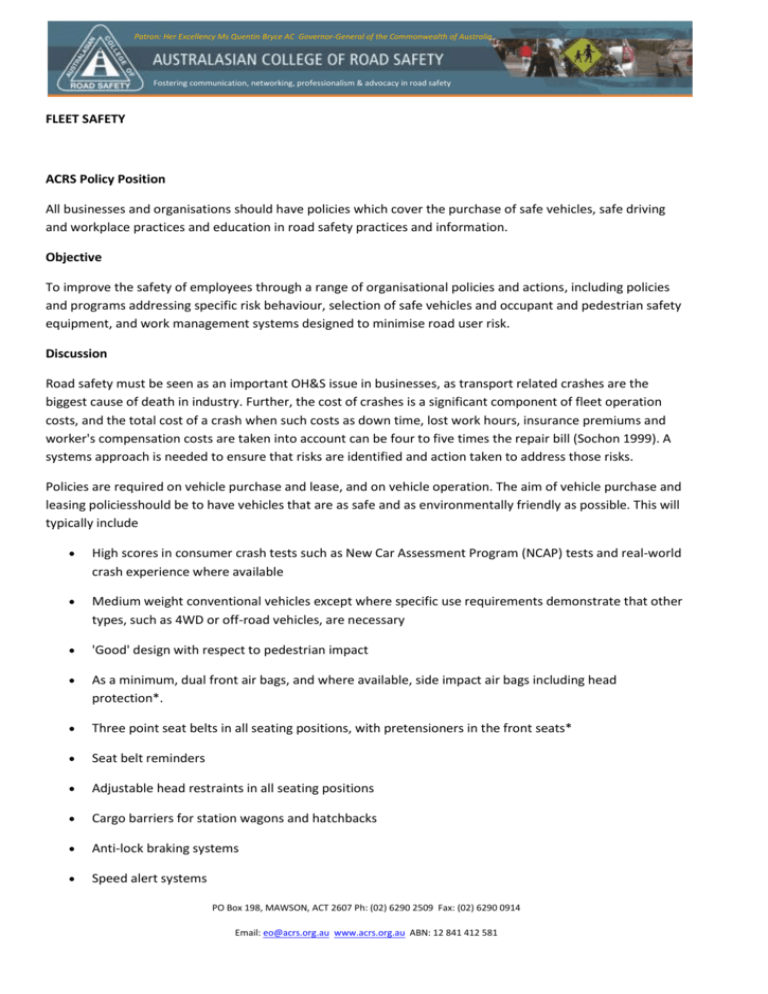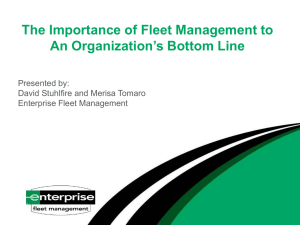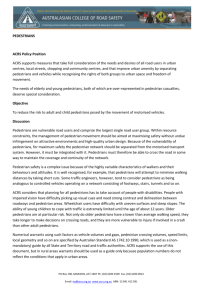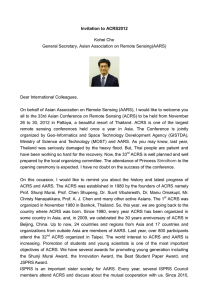leet safety
advertisement

Patron: Her Excellency Ms Quentin Bryce AC Governor-General of the Commonwealth of Australia Fostering communication, networking, professionalism & advocacy in road safety FLEET SAFETY ACRS Policy Position All businesses and organisations should have policies which cover the purchase of safe vehicles, safe driving and workplace practices and education in road safety practices and information. Objective To improve the safety of employees through a range of organisational policies and actions, including policies and programs addressing specific risk behaviour, selection of safe vehicles and occupant and pedestrian safety equipment, and work management systems designed to minimise road user risk. Discussion Road safety must be seen as an important OH&S issue in businesses, as transport related crashes are the biggest cause of death in industry. Further, the cost of crashes is a significant component of fleet operation costs, and the total cost of a crash when such costs as down time, lost work hours, insurance premiums and worker's compensation costs are taken into account can be four to five times the repair bill (Sochon 1999). A systems approach is needed to ensure that risks are identified and action taken to address those risks. Policies are required on vehicle purchase and lease, and on vehicle operation. The aim of vehicle purchase and leasing policiesshould be to have vehicles that are as safe and as environmentally friendly as possible. This will typically include High scores in consumer crash tests such as New Car Assessment Program (NCAP) tests and real-world crash experience where available Medium weight conventional vehicles except where specific use requirements demonstrate that other types, such as 4WD or off-road vehicles, are necessary 'Good' design with respect to pedestrian impact As a minimum, dual front air bags, and where available, side impact air bags including head protection*. Three point seat belts in all seating positions, with pretensioners in the front seats* Seat belt reminders Adjustable head restraints in all seating positions Cargo barriers for station wagons and hatchbacks Anti-lock braking systems Speed alert systems PO Box 198, MAWSON, ACT 2607 Ph: (02) 6290 2509 Fax: (02) 6290 0914 Email: eo@acrs.org.au www.acrs.org.au ABN: 12 841 412 581 Daytime running light system Clear glazing with no added window tinting (additional tinting produces significant reductions in vision, especially at night and in adverse weather conditions) Most fuel efficient engine choice Fuel consumption below the average for new cars Trip computers with fuel consumption monitoring. * Many 'additional' safety features are available on up-market versions or special order. If enough large fleets ask for such items, the unit cost can be reduced considerably. If fleet operators order advanced safety features there is a flow-on to the national vehicle fleet: fleet vehicles are turned over at low mileages and sold on the second hand market, and hence make these features available to the general public. In addition the market power of fleet purchasers (50-60% of the sales of Australian new vehicles are commercial purchases [Murray 2001]) can influence manufacturers to make features more widely available. Fleet operators can also monitor developments and, through purchasing power, encourage the introduction of additional safety features such as anti-whiplash systems, intelligent seat belt reminder systems, load limiters for seat belts, 'smart' speed alert systems that vary by speed limit, automatic daylight running lights. 'Passive' alcohol interlocks and, when available, driver impairment sensing could also be considered. Vehicle operation policies have two objectives: safe vehicle operation (which is obvious) and occupational health and safety considerations. Where the vehicle is defined as a 'workplace' under OH&S legislation there is a duty of care on the employer for the safety of staff while using vehicles. Motor vehicle crashes form a significant part of any business's worker's compensation claims (eg a reported 13% for Telstra [Sochon 1999]). Safety cannot be left to chance. Businesses need to take explicit action to ensure that their employees know and practise safe vehicle use. This includes Strict company policies on speed limits and road rules generally Adherence to at least legal requirements on alcohol and road use Providing information on safety, risky driving conditions and promoting a safe driving culture Not using mobile phones while driving (hands free phones offer no advantage over hand-held phones in terms of distraction from the driving task) Instruction and information to employees about such matters as the impact of fatigue, and company policies to minimize fatigue and prevent impaired driving Safe driving technique; responsibility for keeping the vehicle in tidy and good mechanical condition Economical and environmentally responsible vehicle operation Considering company sanctions (as well as legal sanctions) for breaches, and perhaps bonuses for blameless vehicle use. Model Program PO Box 198, MAWSON, ACT 2607 Ph: (02) 6290 2509 Fax: (02) 6290 0914 Email: eo@acrs.org.au www.acrs.org.au ABN: 12 841 412 581 A model program for developing and implementing fleet safety policies might include: Development Gain management commitment for developing a policy Identify key people such as human resource managers, OH&S managers, fleet managers and industrial relations managers Involve staff in the development of the policy to ensure greater acceptance of the policy at the implementation stage. Develop a policy suited to the organisation's needs As a minimum, the policy should cover: Buying safer cars Education of employees Developing systems to monitor the policy Develop systems to manage the policy The development of systems to manage the process is an important element. Systems can include processes for collecting crash data, vehicle related WorkCover claims, staff interviews when crash claims are received and monitoring of incident reports. Gather Support Once the draft policy has been developed, consider making it available to staff for comment and ensure ongoing support from senior management. Make a specific member of staff responsible for safer driving practices This gives the policy a high profile and makes someone accountable for results. This person will need to be Senior Management or someone empowered by Senior Management to achieve the outcomes. Implementation Launch the Policy Depending on the organisation, this may take the form of: Hold an organisation-wide launch of the policy Discuss the policy at team meetings Distribute the policy to all staff to sign-off. Education program Conduct information sessions covering a wide variety of road safety issues. This will ensure that all staff become aware of the benefits of safer driving. Also use staff meetings and similar activities to convey simple safe driving practices and discuss any employee concerns. PO Box 198, MAWSON, ACT 2607 Ph: (02) 6290 2509 Fax: (02) 6290 0914 Email: eo@acrs.org.au www.acrs.org.au ABN: 12 841 412 581 Maintain awareness of the policy Use educational materials to support the information sessions. For example, email road safety hints to staff prior to peak road crash periods such as long weekends, Easter and Christmas, display promotional posters at all workplaces etc. Also, the policy can be communicated to the general public to raise the organisation's profile. Communications to the public may include articles in the local newspaper or daily press, feature stories in trade journals or magazines etc Monitor and evaluate the policy Collate vehicle and driver information Collect and analyse crash history - if available use insurance company claims benchmarking figures to see how the organisation rates Review and report the program - review safety records regularly. Results and progress should be reported to management and staff on a regular basis. Regular and realistic targets for accident reductions should be set to help focus attention on driver safety. References: Murray W Fleet risk management and work related road safety in Australia, in Roadwise Vol 13 No. 1, pp.5-9 Sochon, P (1999) Improving driver and vehicle safety Fleetsafe policy and guidelines for Local Government in the Southern Sydney Region, SSROC, Sydney ACRS also acknowledges the assistance of fleet safety documents from the Monash University Accident Research Centre (http://www.general.monash.edu.au/MUARC/carpolcy.htm) and The Transport Accident Commission, Victoria PO Box 198, MAWSON, ACT 2607 Ph: (02) 6290 2509 Fax: (02) 6290 0914 Email: eo@acrs.org.au www.acrs.org.au ABN: 12 841 412 581








